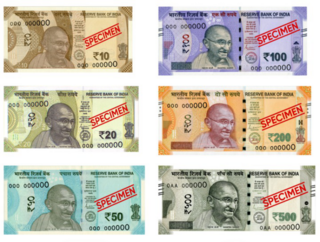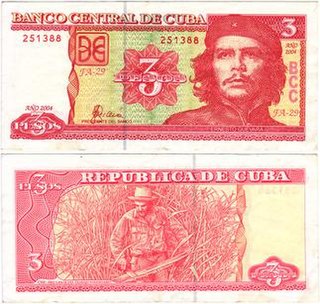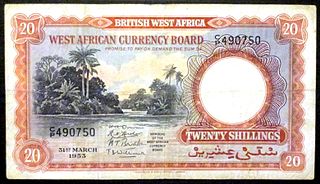
The schilling was the currency of Austria from 1925 to 1938 and from 1945 to 1999, and the circulating currency until 2002. The euro was introduced at a fixed parity of €1 = 13.7603 schilling to replace it. The schilling was divided into 100 groschen.

Rupee is the common name for the currencies of India, Mauritius, Nepal, Pakistan, Seychelles, and Sri Lanka, and of former currencies of Afghanistan, Bahrain, Kuwait, Oman, the United Arab Emirates, British East Africa, Burma, German East Africa, and Tibet. In Indonesia and the Maldives, the unit of currency is known as rupiah and rufiyaa respectively, cognates of the word rupee.

The Portuguese escudo was the currency of Portugal from 22 May 1911 until the introduction of the euro on 1 January 2002. The escudo was subdivided into 100 centavos. The word escudo derives from the scutum shield.

The Macanese pataca or Macau pataca is the currency of the Macao Special Administrative Region of the People's Republic of China. It is subdivided into 100 avos, with 10 avos called ho (毫) in Cantonese.

The Indian rupee is the official currency in India. The rupee is subdivided into 100 paise. The issuance of the currency is controlled by the Reserve Bank of India. The Reserve Bank manages currency in India and derives its role in currency management based on the Reserve Bank of India Act, 1934.

The Sri Lankan Rupee is the currency of Sri Lanka. It is subdivided into 100 cents, but cents are rarely seen in circulation due to its low value. It is issued by the Central Bank of Sri Lanka. The abbreviation Re (singular) and Rs (plural) is generally used, the World Bank suggests SL Rs as a fully disambiguating abbreviation for distinction from other currencies named "rupee".

The ngultrum is the currency of the Kingdom of Bhutan. It can be literally translated as 'silver' for ngul and 'coin' for trum. It is subdivided into 100 chhertum. The Royal Monetary Authority of Bhutan, the central bank of Bhutan is the minting authority of the ngultrum banknotes and coins. The ngultrum is currently pegged to the Indian rupee at parity.

The Colombian peso is the currency of Colombia. Its ISO 4217 code is COP. The official peso symbol is $, with Col$. also being used to distinguish it from other peso- and dollar-denominated currencies.

The krone was the official currency of Austria-Hungary from 1892 until the dissolution of the empire in 1918. The subunit was one hundredth of the main unit, and was called a Heller in the Austrian and a fillér in the Hungarian part of the Empire.

The Cuban peso also known as moneda nacional, is the official currency of Cuba.

The Egyptian pound is the official currency of Egypt. It is divided into 100 piastres, or qirsh, or 1,000 milliemes, but milliemes are no longer used.

The Guyanese dollar has been the unit of account in Guyana since 29 January 1839. Originally it was intended as a transitional unit to facilitate the changeover from the Dutch guilder system of currency to the British pound sterling system. The Spanish dollar was already prevalent throughout the West Indies in general, and from 1839, the Spanish dollar unit operated in British Guiana in conjunction with British sterling coins at a standard conversion rate of one dollar for every four shillings and twopence. In 1951 the British sterling coinage was replaced with a new decimal coinage which was simultaneously introduced through all the British territories in the Eastern Caribbean. When sterling began to depreciate in the early 1970s, a switch to a US dollar peg became increasingly attractive as an anti-inflationary measure and the Eastern Caribbean Currency Authority made the switch in October 1975. The Guyanese dollar is normally abbreviated with the dollar sign $, or alternatively G$ to distinguish it from other dollar-denominated currencies.

The rupia was the currency of Portuguese India sometime after 1668 until 1958. Prior to 1668, the currency unit was Xerafim. In 1666, the Portuguese administration struck a silver coin calling it double xerafin and this was declared equal to a rupia in circulation in India outside of Portuguese possessions. A xerafim was a convertible subunit of rupia, and it was unique to Portuguese colonies in India. One rupia equalled two xerafims.

The pound was the currency of British West Africa, a group of British colonies, protectorates and mandate territories. It was equal to one pound sterling and was similarly subdivided into 20 shillings, each of 12 pence.
The peso was the currency of Paraguay between 1856 and 1944. It replaced the real at a rate of 8 reales = 1 peso. Until 1870, the peso was subdivided into 8 reales. Paraguay then decimalized, with 100 centésimos = 1 peso. The name of the subdivision was changed to centavo in 1874. The peso was replaced in 1944 by the guaraní at a rate of one hundred to one.

The Austro-Hungarian gulden was the currency of the lands of the House of Habsburg between 1754 and 1892, when it was replaced by the Austro-Hungarian krone as part of the introduction of the gold standard. In Austria, the gulden was initially divided into 60 kreuzers. The currency was decimalized in 1857, using the same names for the unit and subunit.

The pound was the currency of Southern Rhodesia. It also circulated in Northern Rhodesia and Nyasaland. The pound was subdivided into 20 shillings, each of 12 pence.
The peso was the currency of El Salvador between 1877 and 1919.

The rial or riyal was the currency of North Yemen, first the Mutawakkilite Kingdom of Yemen, then the Yemen Arab Republic. It is the predecessor to the modern Yemeni rial.

The Somali rupia was the currency in Italian Somaliland from 1909 to 1925. It was subdivided into 100 bese.

























